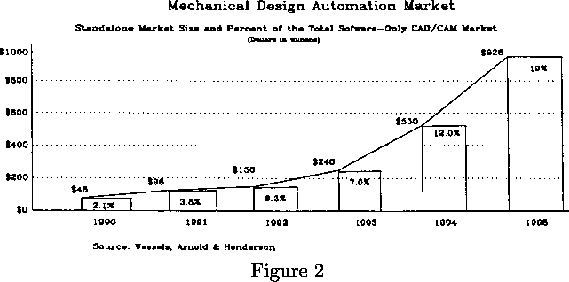

Figure 1 is a representation of the traditional CAD/CAM/CAE market. As one can see, it covers almost every aspect of the design/manufacturing process as we defined it previously. By the estimation of Wessels, Arnold & Henderson, an institutional research company, the mechanical CAD/CAM market ``numbers over 2 million users worldwide and provides a total software revenue potential of $10-$20 billion at a 50% saturation expectation. We estimate the current penetration of the mechanical CAD audience is still less than 20%. More importantly, early users of CAD/CAM systems, using systems based initially on mainframes and minicomputers and later on desktop engineering workstations, are ready for a new level of design capability.''
These words were actually written to accompany an analysis of the potential for Parametric Technology's product, but they are as true for Autodesk as they are for PTC. In that analysis, the research company found that the most receptive customers to PTC's products were experienced CAD users who were frustrated with the disjointed process as actually provided by the turnkey vendors.
The failure of the turnkey vendors to provide integrated solutions to this process is shown by comparing the revenues obtained from a single part of the process versus the time manufacturing companies actually spend on it.
The conceptual design phase represents a relatively small source of revenue, but consumes more than 15% of the design/manufacturing process. According to a British Aerospace study, over 60% of the total money spent on a project is actually committed at the conceptual design stage, when very little is know about what the project will actually entail.
The traditional vendors have not sufficiently addressed this stage of the process, effectively causing the bulk of conceptual design being done with inadequate tools, including drafting and drawing systems.
As newer, more powerful, and more intuitive products become available, we should expect to see a rapid readjustment of spending to begin to match the commitment of actual resources, and the revenues arising from products which address the conceptual design phase should grow rapidly.
Wessels, Arnold & Henderson has studied a new market which they call the mechanical design automation market (MDA), and estimate that this market will grow well over 50% per year for the next six years, up from about $20 million in 1989 to well over $1.0 billion in 1995. They project that penetration of the entire CAD/CAM software-only market will then still be less than 20%. Figure 2 shows the prediction for growth of this market.

With respect to the drafting segment of the market, they also have a great deal to say, and it is worth quoting directly from their study.
``The Drafting segment of the mechanical CAD/CAM industry is characterized by several new participants, namely Autodesk, who have caused severe dislocation to the large turnkey CAD/CAM vendors who dominated the industry at the beginning of the 1980's. Autodesk, among others, entered the market offering slightly lower functionality for one-tenth the cost ... compared to some drafting programs selling for well over $20,000 per seat....
``In the future, we estimate the drafting segment to continue to shrink as more of the process moves into the conceptual stage of development, causing further dislocation to the well-established vendors. Autodesk ought to be able to transition this move with its next generation of products and act as a catalyst for many users who want low-cost replacements for drafting and a strategy for the next several years to conceptual design (italics mine).''
Editor: John Walker